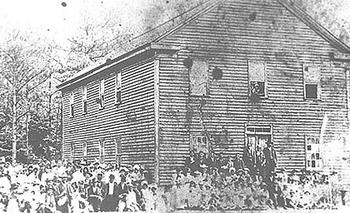On March 7, 1887, Croatan Normal School was established after legislation sponsored by Representative Hamilton McMillan of Robeson County was enacted by the General Assembly of North Carolina. The law, which was in response to a petition from American Indians of the area, established a Board of Trustees and appropriated $500 to be used only for salaries. The school was established to train American Indian teachers.
Learn more about UNCP's Founders
A clapboard, two-story building was constructed by local Indians at a site about one mile west of the present location, and the school opened with 15 students and one teacher in the spring of 1888. For many years, the instruction was at the elementary and secondary level, and the first diploma was awarded in 1905.
The school was moved to its present location in Pembroke, the center of the Indian community, in 1909. The General Assembly changed the name of the institution in 1911 to the Indian Normal School of Robeson County, and again in 1913 to the Cherokee Indian Normal School of Robeson County. In 1926, the Board of Trustees added a two-year normal (teacher training) program beyond high school and phased out elementary instruction. The first ten diplomas were awarded in 1928, when the state accredited the school as a “standard normal school.”

In 1933, two-year college (junior college) coursework was added. In 1936, the third year of the normal and college curriculum was added, and, in 1939, a fourth year was added after the institution received a “senior college” rating. The first four-year degrees were conferred in 1940. In recognition of its new status, the General Assembly changed the name of the school in 1941 to Pembroke State College for Indians. Between 1939 and 1953, it was the only state-supported four-year college for Indians in the nation. The scope of the institution was widened in 1943 when non-teaching baccalaureate degrees were added, and, in 1945, when enrollment, previously limited to the Indians of Robeson County, was opened to people from all federally recognized Indian groups. In 1949, the General Assembly shortened the name to Pembroke State College.
The Board of Trustees approved the admission of white students up to 40% of the total enrollment in 1953, and, following the Supreme Court’s school desegregation decision, opened the College to all qualified applicants without regard to race in 1954. Growth of over 500 percent followed during the next eight years. In 1969, the General Assembly changed the name again to Pembroke State University and designated the institution a regional university. Such universities were authorized “to provide undergraduate and graduate instruction in liberal arts, fine arts, and science, and in the learned professions, including teaching” and to “provide other graduate and undergraduate programs of instruction as are deemed necessary to meet the needs of their constituencies and of the State.”
Three years later, in 1972, the General Assembly established the 16-campus University of North Carolina with Pembroke State University as one of the constituent institutions. The new structure was under the control of the Board of Governors, which was to coordinate the system of higher education, improve its quality, and encourage economical use of the state’s resources. The Board of Governors approved the implementation of the Master of Arts in Education program by Pembroke State University in 1978, as well as several new undergraduate programs. Since that time, additional baccalaureate programs have been added, including nursing, and master’s level programs have been implemented in business administration, public administration, school counseling, and clinical mental health counseling.
Pembroke State University celebrated its centennial in 1987. On July 1, 1996, Pembroke State University officially became The University of North Carolina at Pembroke.
In 2000, a major in applied physics and four new Master of Arts programs were added. An Office of International Programs and the Esther G. Maynor Honors College were also instituted to enhance scholarship. Since then, the University has added new baccalaureate programs, including Spanish, environmental science, and geo-environmental studies, as well as new graduate degrees, including the Master of School Administration (M.S.A.), the Master of Arts in Teaching (M.A.T.), and the Master of Social Work (M.S.W.). Many classes at the undergraduate and graduate levels are available through distance learning, including the Internet.
On July 5, 2005, North Carolina Gov. Mike Easley signed into law Session Law 2005-153, declaring The University of North Carolina at Pembroke as "North Carolina's Historically American Indian University."
Between March 2012 and May 2013, the university celebrated the 125th anniversary of its founding.
Today, The University of North Carolina at Pembroke has more than 8,200 students from diverse backgrounds. The University offers more than 150 pathways to graduate and undergraduate degrees.
